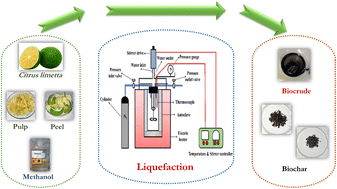Citrus limetta fruit waste management by liquefaction using hydrogen-donor solvent
Abstract
The liquefaction of Citrus limetta fruit waste (both pulp and peel) in a hydrogen-donor solvent has not been reported in the literature and authors considered the same as the objective of this work. Thus, results on waste management of this potential fruit wastes by liquefaction in hydrogen-donor methanol solvent at 260 °C temperature, residence time of 30 min, and 1 : 2, 1 : 3 and 1 : 4 biomass-to-solvent ratios were reported in this work. The aim was to achieve biofuels of high quantity and quality from this waste, which would otherwise be disposed of without any value addition. A maximum of 12.5 wt% of biocrude yield was found from Citrus limetta peel biomass, which was higher than that from the thermochemical conversion of other citrus fruit waste biomasses. Biocrude having higher heating value (HHV) of 26.76 MJ kg−1 from Citrus limetta pulp, when the feed biomass pulp-to-solvent ratio was 1 : 4, found to be the best outcome of this study. Biocrude and biochar have also been extremely characterized using several advanced techniques such as Gas Chromatography Mass Spectrometry (GC-MS), Fourier Transform Infrared Spectroscopy (FTIR), and Field Emission Scanning Electron Microscopy (FESEM), etc. Finally, the novelty of this work is not only obtaining higher yield of biocrude but also better HHV compared to other similar studies in the literature.



 Please wait while we load your content...
Please wait while we load your content...